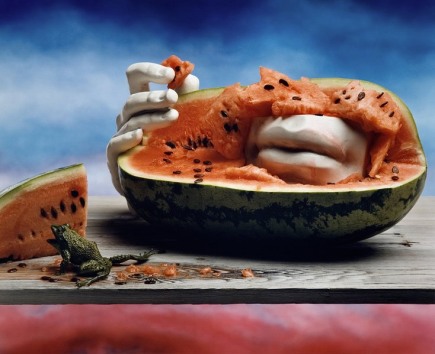Greg Neville, North Melbourne light, 2015
.
Jo Whaley, Knows No Secrets, 1991
Still life artist Jo Whaley is an example of someone who’s early career comes back and influences their later one. As an undergraduate student in San Francisco she studied painting before her postgrad studies in photography. She then worked for several years as a scenic artist for the San Francisco Opera and other theatre companies. This job meant painting backgrounds, arranging props and working with lighting designers.
These art and theatre experiences later became the core of her photographic practice – she treats her still life photographs as small theatrical sets. The colour, lighting and placement of props evoke the stage setting of her early career, the difference is she works in the small arena of the still life table.
You can see more of her beautiful still lifes at her website, jowhaley.com. She has also published a book of her still life photographs in The Theater of Insects.

Jo Whaley, Consuming Habitat, 1992
Jo Whaley, Pulp Exposed, 1992
.
Greg Neville, Black Hill, 2015
Black Hill is a beautiful, heavily forested reserve near Kyneton, an hour from Melbourne. It was ravaged by bushfire in January in a holocaust that I witnessed. This was a genuine firestorm that worked its way across the entire hill.
It has been closed off since then but is about to re-open. Last weekend I walked through and took these pictures.
Wim Wenders, from Written in the West, Revisited
When the film director Wim Wenders was scouting locations for his 1984 film Paris, Texas, he captured the texture of his subject in a series of fine photographs. Following the success of his film, they were published in a monograph book, Written in the West.
The camera Wenders used was the classy 6×7 Plaubel Makina, the medium format film gathering in all the subtle detail and light of the American Southwest. When he later returned to the subject, near a real town in Texas that is actually called Paris, he used another medium format camera, the Fuji 6×4.5. These new images have now been presented in a second edition of the book called Written in the West, Revisited.
These photographs are fine studies of the West. They are broadly in the style of the New Color Photography, that moment in the 1980s when color took hold of fine art photography. More specifically they evoke the work of Stephen Shore whose Uncommon Places had been published in 1982.
Wenders’ images have an atmosphere in keeping with his movie which is about lost people searching for each other. The absence of people in the photographs creates a melancholic mood that adds an almost narrative quality to the images.